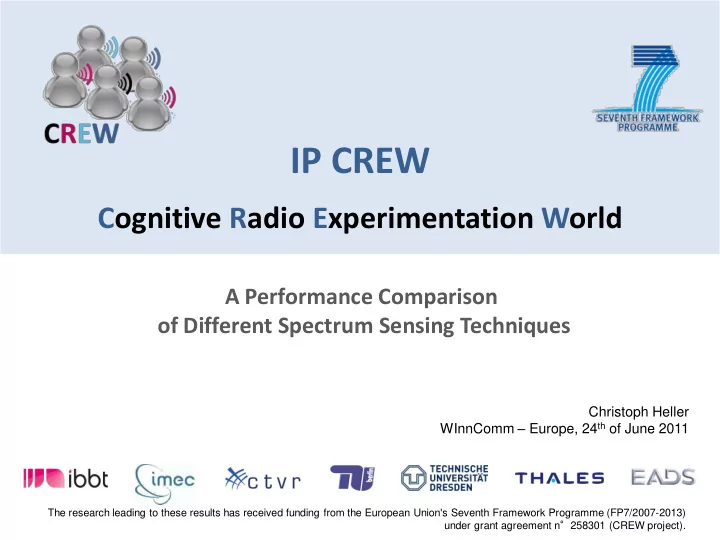

IP CREW Cognitive Radio Experimentation World A Performance Comparison of Different Spectrum Sensing Techniques Christoph Heller WInnComm – Europe, 24 th of June 2011 The research leading to these results has received funding from the European Union's Seventh Framework Programme (FP7/2007-2013) under grant agreement n ° 258301 (CREW project).
Structure of this Presentation ■ The FP7 Project CREW ■ Purpose of Spectrum Sensing Experiments ■ Used Sensing Equipment ■ Experimentation Setup ■ Results ■ Conclusion & Next Steps 1
The FP7 Project CREW ■ Project Partners: IBBT, imec, CTVR, TU Berlin, TU Dresden, Thales, EADS ■ Project Start: October 2010 ■ Project Goal: Development of a Federated Testbed for Cognitive Radio Experimentation 2
The FP7 Project CREW 3
Purpose of Spectrum Sensing Experiments ■ The CREW Project offers the unique chance to compare a great number of sensing solutions from different project partners ■ Cross-Platform Study ● Comparison of inexpensive off-the-shelf to customized sophisticated solutions ● Comparison of different processing approaches ● Benchmarking with respect to – Sensing accuracy – Sensing speed – RF flexibility 4
Used Sensing Equipment ■ Wi-Spy 2.4x (MetaGeek, LLC.) ● Low-cost spectrum sensor for 2.4 GHz ISM band ● We used Kismet Spec-tools for Linux OS to acquire power spectral density estimates in a non-propriety format ● Spectrum dumps are performed as fixed bandwidth sweeps of the entire ISM 2.4 GHz band ● The resolution bandwidth is 327 KHz 5
Used Sensing Equipment ■ AirMagnet Spectrum XT ● USB product designed for troubleshooting and deploying WLAN networks ● ISM 2.4 GHz/ 5GHz ● internal or external antenna ● Manufacturer specs: – amplitude accuracy: +/- 2dB – RBW 156.3 kHz – sweep time: 64 msec per 20MHz ● Current limitations: – CSV log files: 1 report/second – scans only full bands (no range config possible) 6
Used Sensing Equipment ■ TelosB ● Sensor network hardware platform developed at UC Berkeley ● Uses the IEEE 802.15.4-compliant CC2420 transceiver, which can measure RF energy in 2.4 GHz ISM band – IEEE 802.15.4 channel (resolution) bandwidth is 2 MHz, – Possbile CC2420 center frequencies are 2400, 2401 , … 2483 MHz ● Our setup (TinyOS 2 application) – Sweep over spectrum in steps of 2 MHz (e.g. 2400->2402->2404 MHz) – Take one RSSI sample per channel (signal power averaged over 192 us) – Output data -> total: 2 ms per sample (sampling frequency 500 Hz) 7
Used Sensing Equipment ■ USRP1 (Ettus Research) ● Highly flexible low cost RF transceiver. ● Ideal for use in software defined radio. ● Operating frequencies can be changed based on which daughterboard is used. ● For these experiments RFX2400 daughterboard used which operates between 2.3 and 2.9 GHz. ● Can sample up to 8Msamples/sec. 8
Used Sensing Equipment ■ Iris ● Component based architecture for software defined radio ● Designed and developed in CTVR, Trinity College Dublin ● Highly reconfigurable ● Radio set up as a chain of components ● Components used can be swapped or have their parameters changed in real time. 9
Used Sensing Equipment ■ imec Advanced Spectrum Sensing ● Low power/low cost SDR RFIC prototype ● Input range from 0.1 up to 6 GHz ● Programmable channel bandwidth from 1 up to 40 MHz ● On-chip 65MS/s 10b ADC ● 5 mm 2 – 40nm TSMC technology 10
Experimentation Setup ■ Measurements took place at a lecture room ● Signal source on tabl at one side of the room ● Sensing equipment located on table at other side 11
Experimentation Setup ■ Test Signal ● Source: Anritsu MG3700A RF Signal Generator ● Characteristic: DVB-T Signal – Center Frequency: 2.477 GHz – Bandwidth: 8 MHz – CP Ratio: 1/4 – Power: -4 dBm ■ Scenarios ● Slow On/Off Pattern (60 s On / 60 s Off) ● Fast On/Off Pattern (10 ms On / 100 ms Off) ● Change of TX Power (-4 dBm / -15 dBm / -30 dBm) ● Change of Distance between TX and Sensing Nodes ● Change of Center Freq. (2.404 GHz : 8 MHz : 2.496 GHz) ■ Channel Characteristics ● Static (no people in room) ● Dynamic (10 … 15 people moving randomly around between TX and sensing nodes) 12
Medium and low power scenarios ROC for for Tx power of -15dBm ROC for Tx power of -30dBm 13
Multipath scenario Multipath scenario ROC plot for -4dBm Multipath scenario ROC plot for -15dBm 14
Conclusions ■ Comparison of sensing devices… ■ First Step for Standardized and Systematic Comparison of Different Spectrum Sensing Solutions ■ Pros and Cons of Presented Approach ● Realistic signal propagation effects due to real wireless channel ● Limited comparability of results due to different channel characteristics between signal source and each sensing node 15
Next Steps ■ Improving Comparability and Objectivity of Results ● Development of benchmarking criteria for wireless spectrum sensing ● Establishment of a better reproducible signal propagation environment – Usage of coax cables instead of wireless channel – Usage of fading channel simulator 16
Recommend
More recommend